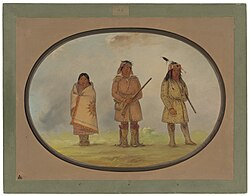Indigenous peoples of the Northeastern Woodlands

Indigenous peoples of the Northeastern Woodlands are American Indian tribes with similar cultures in the northeastern and the Midwest United States and southeastern parts of Canada. There are three areas in the Northeastern Woodlands. The coastal area runs from South Carolina up to Canada. Saint Lawrence Lowlands includes parts of Ontario and New York. The Great Lakes-Riverine area is around the Great Lakes. There are different landscapes in the region. They include coasts, forests, mountains and lowlands.[1] The Northeastern Woodlands are surrounded by the Subartic, Great Plains and Southeastern Woodlands. Algonquian, Iroquoian, or Siouan are the three language groups of the area.[2]
Language Groups and Tribes
Algonquian-speaking tribes are Abenaki, Accomac, Delaware (Lenape), Fox, Illinois, Kickapoo, Malecite, Massachusett, Menominee, Miami, Mi’kmaq (Micmac), Mohegan, Mohican (Mahican) Montauk, Nanticoke, Niantic, Nipmuc, Narragansett, Nauset, Ojibwa, Ottawa, Passamaquoddy, Penobscot, Pennacook. Pequot, Pocomtuc, Potawatomi, Powhatan, Sauk, Shawnee, Wampanoag and Wappinger. These tribes were all over the Northeast and along the coast except near the Great Lakes.
Iroquoian speaking tribes include Oneida, Onondaga, Cayuga, Seneca, Huron, Mohawk, Petun, Tionontati, Neutral, Wenrohronon, Tuscarora, Erie, Susquehannock, and Laurentian Iroquois. The Five Nations included Mohawk, Oneida, Onondaga, Cayuga, and Seneca. They were part of the Iroquois Confederacy.
Siouan language tribes include Winnebago, Tutelo and Yankton. Most Siouan are closer to the Plains region.
History
The Hopewell culture developed in 200 BC. They were in the Midwest and Ohio. The culture disappeared after 400 CE.[3] The Algonquian and Iroquoian tribes developed around 1100. This was in present-day New England.[4] The Iroquois was a powerful confederacy of tribes from about 1400 to 1700 CE.[5] Lenni-Lenape lived in present-day Delaware and New Jersey. They were forced off their lands by Europeans.[6] The Powhatan Confederacy (Tsenacommacah) were tribes in present-day Virginia. Chief Powhatan was the father of Pocahontas. The region of the Powhatan was the first area that British settled, including Jamestown.[7]
Culture
Northeast Woodland Natives usually lived in wigwams or longhouses. They traded wampum, which were shell beads.[8] Natives used the birchbark canoe for hunting, warfare and fishing. The main crops were the Three Sisters. This included winter squash, maize (corn), and climbing beans. They were grown together to improve growth.[9] There were villages of a few hundred people. Some areas like Cahokia had many people. Men usually planted and harvested, while women processed plants. The clan was an important social group. They were often named after animals like the bear, hawk, turtle or wolf. Natives believed in spiritual force that was everywhere. Manitou was the spiritual life force. It could reveal itself as the Great Spirit.[10] Totem animals were also sacred.
Indigenous Peoples Of The Northeastern Woodlands Media
Joseph Brant, a Mohawk, depicted in a portrait by Charles Bird King, circa 1835
Three Lenape people, depicted in a painting by George Catlin in the 1860s
A map of the Northeastern United States showing the demarcation between Iroquoian (purple) and Algonquian (pink) Indian tribes in present-day New Jersey, Pennsylvania, and New York state
Related pages
References
- ↑ "Northeast Woodlands". Native American Art Teacher Resources. Retrieved 2022-07-30.
- ↑ "Native American Cultures". HISTORY. Retrieved 2022-07-30.
- ↑ "Hopewell Culture - Ohio History Central". ohiohistorycentral.org. Retrieved 2022-07-30.
- ↑ Klein, Milton M. (ed.) and the New York State Historical Association, The Empire State: A History of New York, Cornell University Press, Ithaca, New York, 2001, ISBN 0-8014-3866-7
- ↑ Horatio Gates Spafford, LL.D. A Gazetteer of the State of New-York, Embracing an Ample Survey and Description of Its Counties, Towns, Cities, Villages, Canals, Mountains, Lakes, Rivers, Creeks and Natural Topography. Arranged in One Series, Alphabetically: With an Appendix… (1824), at Schenectady Digital History Archives, selected extracts, accessed December 28, 2014
- ↑ "Native People of NJ - Lenni-Lenape". www.usgennet.org. Retrieved 2022-07-30.
- ↑ "Who were the Powhatan Indians and how did they live?". JYF Museums. Retrieved 2022-07-30.
- ↑ "NORTHEAST AMERICAN INDIAN FACTS". native-american-indian-facts.com. Retrieved 2022-07-30.
- ↑ Mount Pleasant, Jane (2006). "The science behind the Three Sisters mound system: An agronomic assessment of an indigenous agricultural system in the northeast". In Staller, John E.; Tykot, Robert H.; Benz, Bruce F. (eds.). Histories of Maize: Multidisciplinary Approaches to the Prehistory, Linguistics, Biogeography, Domestication, and Evolution of Maize. Amsterdam: Academic Press. pp. 529–537. ISBN 978-1-5987-4496-5.
- ↑ Bragdon, Kathleen J. (2001). The Columbia Guide to American Indians of the Northeast. New York: Columbia University Press. p. 18.


